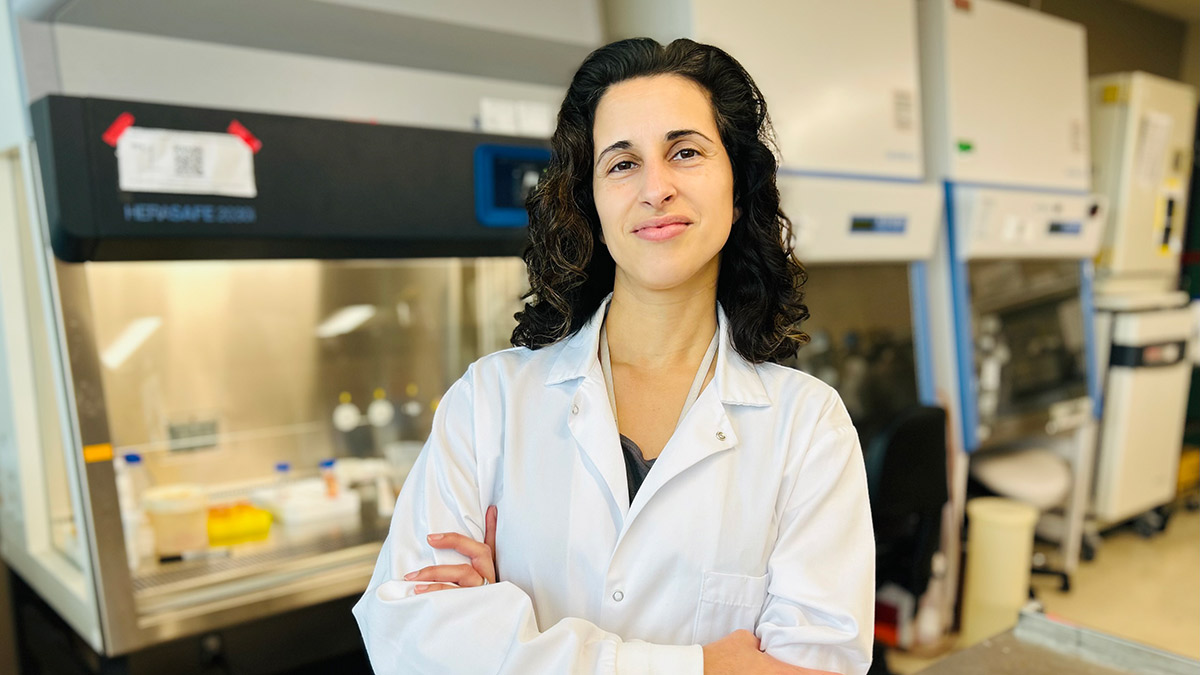Waking up in the recovery room after laparoscopic surgery, Krista Pakenham asked the nearby nurse who was checking her vital signs if they had found endometriosis. The answer was yes.
Tears streamed down her cheeks, as a flood of relief washed over her. After four years of monthly ER visits, dismissive doctors and a misdiagnosed case of appendicitis, Pakenham had finally received an explanation for the pain she’s suffered.
“I was so happy to have an answer. Knowing it wasn’t all in my head and that I was actually having pain and there was a reason behind it,” Pakenham told Capital Current.
This is the reality for many endometriosis sufferers trying to obtain a diagnosis. According to global estimates, from the onset of symptoms to the identification of the disorder, individuals can wait anywhere from four to 11 years. This delay greatly reduces quality of life and can worsen the burden of symptoms.
To combat these wait times, College La Cité in collaboration with SYNG Pharmaceuticals Inc. (SYNG pharma) has begun a study meant to develop a non-invasive endometriosis rapid detection kit called EndoID that could help facilitate earlier diagnosis.
“Basically, doctors who would have this kit could provide it to their patients and then within minutes, they would actually know whether they have a diagnosis of endometriosis or not,” Dr. Michelle Bamji-Mirza, researcher at the Technology Access Centre in Bio-Innovation (TAC-B) at College La Cité, said.
What is endometriosis?
Endometriosis is a gynaecological disorder often characterised by chronic inflammation. Tissue resembling endometrium — the lining of the uterus — begins to grow outside the uterus and can cause ovarian cysts, superficial lesions, scar tissue, deeper nodules and adhesions (tissue that binds organs).
Although the endometrial-like tissue commonly impacts the ovaries, fallopian tubes and pelvic tissues, it can grow in many other areas including the bladder, the intestines, the liver and the diaphragm.
“It is a condition that has chronic and inflammatory characteristics as well. So, every month when there is bleeding, it causes further scarring and injury to those organs where it’s attached,” Dr. Sukhbir Singh, head of Obstetrics and Gynaecology at The Ottawa Hospital, told Capital Current.
Endometriosis often causes pain in the pelvis and lower abdomen along with other common symptoms including heavy bleeding during or between periods, fertility issues, pain during or after sex and pain when urinating or defecating.
While endometriosis has no known cure, there are treatment options to manage the pain and improve fertility issues: hormone therapy, pain medications and surgical treatments. Factors such as age, the severity of symptoms, the severity of the disease and whether a woman wants children all impact treatment options.
While a hysterectomy, ovary and fallopian tube removal can alleviate most of the symptoms, according to a study Recurrence of endometriosis after hysterectomy, there is a 10 per cent recurrence rate of endometriosis symptoms and the required reoperation rate is 3.7 per cent. Should some ovarian tissue be preserved, endometriosis symptom recurrence rates increase, as do required reoperation rates.
Barriers to receiving a diagnosis
With no family doctor to follow her progress, nor a gynaecologist with adequate knowledge on endometriosis, Pakenham was forced to blindly advocate for her own care.
“I moved here from Kingston so I didn’t have a family doctor,” Pakenham said, “There were no referrals, I had no one to follow up with. I did have a gynaecologist but they didn’t know much about endo and they didn’t really know what to do about it.”

On a monthly basis when the endometriosis flared up — often coinciding with her period —she visited walk-in clinics or ended up in the ER to receive help for the pain.
The trips to the ER became so frequent that she needed to bring a family member or friend to prove she wasn’t just seeking pain medication.
“For about four years it was definitely a lot,” Pakenham said. “I would have to have a family member come and be like ‘no she’s in a lot of pain, this is real, something’s happening; we need to figure this out.’ “
Despite the number of times she went, Pakenham found the ER and walk-in clinic practitioners to be of very little help. Between a lack of knowledge and expertise to diagnose the issue along with a dismissal of the pain altogether, a referral to see an expert and access services was significantly delayed.
In the four years before being diagnosed, Pakenham said she had seen and consulted with between five and 10 doctors before a practitioner at a walk-in clinic took her claims seriously and brought her on as a patient.
“The main thing that they’ll do is they give you an ultrasound and then they’ll just pump you full of pain meds and kinda say ‘follow up with your gynaecologist’ if they think it’s something to do with that. Otherwise they don’t know and say go home and sleep it off,” Pakenham said.
According to the study Prevalence, Symptomatic Burden and Diagnosis of Endometriosis in Canada: Cross-Sectional Survey of 30,000 Women, endometriosis impacts seven per cent of women in Canada — predominantly those of reproductive age. However, by global estimates one in 10 women are affected.
Despite how common endometriosis is, the disorder lies far behind others in terms of research and understanding — which can affect how doctors interpret and treat the disease.
“There has been a dismissal of understanding the reproductive health concerns of women for forever; and so dismissing painful periods, dismissing concerns that may have to do with the uterus, ovaries, fallopian tubes add to that delay in diagnosis,” Dr. Singh said.
Based on the same study, Canadian women experience an average delay between the time of onset symptoms to an endometriosis diagnosis of 5.4 years. Numerous barriers such as the presentation of symptoms that can be attributed to many illnesses and a lack of understanding from both patients and practitioners add to that delay.
In the aftermath of COVID-19, new barriers have arisen, further delaying the time it takes for individuals to obtain an endometriosis diagnosis, according to Dr. Singh.
“The new barriers since the pandemic in our health-care system is a lack of family doctors and primary care providers, a lack of access to gynaecologists and finally a lack of true support for expertise for those who provide care for endometriosis,” Dr. Singh said.
Another hindrance lies in the lack of straightforward tests for endometriosis according to the study, Barriers to a Timely Diagnosis of Endometriosis. Although there are some non-invasive detection methods such as diagnostic imaging, the main screening method for endometriosis is a laparoscopy test. This can prove a challenge as referrals to specialist services are often delayed
Based on the study Prevalence, Symptomatic Burden and Diagnosis of Endometriosis in Canada: Cross-Sectional Survey of 30,000 Women, the mean physician-related delay between the first time consulting with a physician and obtaining a diagnosis was 2.3 years — with those consulting an average of three physicians on endometriosis prior to being diagnosed.
What is EndoID?
With research assistance and financial support from SYNG Pharmaceuticals Inc, College La Cité has begun research to develop EndoID — a non-invasive endometriosis rapid detection kit that can provide patients with another avenue to help facilitate earlier diagnosis.
“The delay in diagnosis may lead to lack of appropriate treatment and timely treatment. You delay helping individuals in pain and who have fertility issues to get the right care,” Dr. Singh said. “It [early diagnosis] validates their pain — they actually have something that can be treated. Number two is it reduces the development of chronic pain.”
The project was first developed by SYNG Pharma, an Ontario-based biotechnology company committed to developing diagnostic and therapeutic tools against endometriosis. To carry out the study, the company approached the Technology Access Centre in Bio-Innovation (TAC-B) at College La Cité with its research.
College La Cité’s TAC-B is one of many TACS (Technology Access Centres) across Canada affiliated with colleges whose main purpose is to accelerate industrial research.
“We were approached by the company to do this project and we jumped on it because it’s something that can help many people who are suffering,” Dr. Bamji-Mirza said.
EndoID will be a blood-based diagnostic test that can use blood from the veins or menstrual effluent. The lateral flow device (LFD) will target certain markers in the blood through a testing technique that uses a specific antibody (immune system protein) to detect the biomarker by binding to it, which will produce a positive or negative result.
“A potential patient or an individual could take their menstrual effluent, period blood, and put it on this detection kit that we would soon develop … and then after a few minutes would know whether they may have endometriosis or not,” Dr. Bamji-Mirza said.
Preliminary Research by Vinay Singh, CEO and founder of SYNG Pharma (along with other researchers), found elevated levels of Synuclein Gamma (SNCG) — a protein involved in cellular growth and division — in ovarian endothelial cells of endometriosis lesions, particularly in peri-vascular regions (tissues surrounding blood vessels).
Other research has connected B-cell lymphoma-6 (BCL-6), a protein that regulates the transcription of genetic information, as a promising biomarker for endometriosis.
High levels of BCL-6 has been observed during the secretory phase of menstruation (also known as the luteal phase where the production and secretion of progesterone and estrogen occurs) and in the endometrium epithelium in women with endometriosis.
Based on this research, SYNG Pharma has developed antibodies that will be able to bind to these proteins. The study will use an in-vitro ELISA test (A testing technique that uses a reaction with a specific antibody to detect/measure the proteins) to analyze a serum derived from participant blood samples.
The ELISA test will be used to detect and measure the concentrations of SNCG and BCL-6 in these serums.
The study is recruiting participants who will be asked to provide a menstrual effluent and venous blood sample. The samples will be collected with help from the CSanté Medical Clinic at College La Cité which will then be sent to TAC-B to be stored and analyzed.
“We are looking for both people who suffer from endometriosis and those who do not. So basically anyone with a uterus and between the ages of 19 and 45, ” Dr. Bamji-Mirza said, “There are a few other exclusion and inclusion criteria that can be found on our registration form.”
Innovation in health care always comes with a risk. According to Dr. Sukhbir Singh, while these tests would be a useful tool in the presence of health care physicians, should they become accessible for at-home settings, a false positive or a false negative may cause confusion, invalidation and misdiagnosis.
“I think ultimately it’s good to have more awareness and more options, at the same time we have to be careful that nothing can replace a health-care provider evaluation, the appropriate and right imaging and examination,” Dr. Singh said.
Once the kits are developed, SYNG Pharma plans to provide them to clinics, so doctors or health-care professionals can do the test and provide clear context on what the results mean as well as the next steps. In the future there is a possibility these tests would be sold in drugstores for wider public use and accessibility.
While this test might not provide a definitive diagnosis, still likely requiring a combination of screenings, this could open the door to treatment options to alleviate some pain sooner.
For those like Krista Pakenham, this non-invasive detection kit could promise a new hope in the landscape of endometriosis care, widening the conversation and understanding of the disorder while providing new generations with an accessible method of diagnosis.
When Pakenham was finally diagnosed with endometriosis, the disorder had progressed, with endometrial-like tissues found outside the uterus.
“It was like everywhere. It was all in my uterus, all over my bladder, my ovaries. The appendix they had taken out had endometriosis on it, ” Pakenham said.
Pakenham has undergone various pain medications, hormone therapies and 10 laparoscopic surgeries to remove endometriotic lesions and cysts. Through a laparoscopic cleanup surgery, she was able to get pregnant twice. This has brought her joy but also worry for her daughter’s future.
“I read that it [endometriosis] can be hereditary, and I have a daughter so for me to think about her having to go through everything I went through is heartbreaking and to know that there could be a simple blood test to help diagnose to get the proper healthcare is just life changing.”




